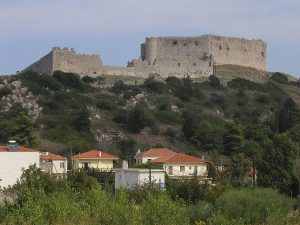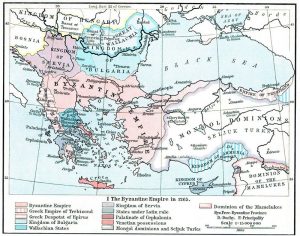Yesterday’s post introduced John Cantacuzenus, one of the most significant of the last Byzantine emperors who faced a series of impossible dilemmas which saw a further crumbling of the empire from its already dilapidated state. Before looking at the difficulties of his reign, let us see how the empire got to such a wretched state in the first place.
The Latin Empire
The beginning of the fall of Byzantium can be given a precise date: the 12th of April, 1204. That is when the Fourth Crusade, an expedition that had set out to conquer Egypt, sacked Constantinople and forced the imperial court into exile for 57 years.
It was one of the more bizarre and convoluted episodes in history. In 1202, an army of mostly French and Italian crusaders had assembled in Venice to be transported across the Mediterranean. Too few showed up to pay for passage on the fleet they had contracted with the Venetians, for which the latter had already outlaid considerable expense. With the crusader army now stranded on the Lido and their irritated hosts unable to recover their investment, the two parties were at an impasse.
It was resolved with a mercenary contract of sorts: the crusaders would assist their creditors in recovering some rebellious territories, after which they would be conveyed overseas. Along the way, they encountered an opportunity too good to pass up: a pretender to the Byzantine throne, the son of a deposed emperor. A new plan was devised: the expedition would sail to Constantinople, where it would intimidate the Byzantines into installing a pretender to the throne, who would then reward them with a sum of gold sufficient to make good the crusaders’ debt.

The first half of the plan succeeded brilliantly; an empty treasury precluded the second. Enraged, the Franks (a term used in the Middle Ages to mean Western Europeans) besieged Constantinople and subjected it to a brutal sack in April 1204. Now in possession of the most magnificent city in the world, these would-be crusaders abandoned their previous plans and set about conquering what Byzantine territory they could. The result was what came to be called the Latin Empire: Frankish knights held fiefs as vassals of the emperor, while many ports and islands were ruled directly by Venice (“Latin,” like “Frank,” refers to Western Europeans, who followed the Latin rite of the Roman Church, as opposed to the Greek rite of the Byzantine Church).
The Byzantine court and army had meanwhile fled to nearby Nicaea, in Anatolia, where a new line of emperors was established. Rival claimants to the throne also set themselves up in Epirus (northwestern Greece) and Trebizond (northeastern Anatolia), each claiming imperial legitimacy. Over the next half-century, the Nicaeans succeeded in recovering territory in Asia and Europe, finally managing to retake Constantinople itself in 1261 under Emperor Michael VIII Palaeologus.
The Final Two Centuries
The half-century absence of the imperial court from the capital had given a huge opportunity to Byzantium’s enemies. The Fourth Crusade had pulled off an astounding coup by seizing Constantinople, but the state it left in its wake was militarily weak: it had far too few knights, and could not rely on the loyalty of the Greek population to provide fresh levies. In short, it could not safeguard Byzantine lands in the place of the legitimate emperors.

The traditional enemies of Byzantium perceived this weakness and pounced. The Bulgarians, a once-potent force laid prostrate by past emperors, rose from the ashes: they had won major victories over the Latins and now controlled a sprawling territory. The Kingdom of Serbia had shaken off its vassalage to Byzantium, and would soon start gobbling up territory in the western Balkans. In Asia, the Seljuk Turks, hitherto pushed back to eastern Anatolia, had retrenched and were steadily driving toward the Aegean. And in the Peloponnese and central Greece, Latin barons defiantly held out against Byzantine forces.
Nor were things in a happy state within the borders. The crusaders had replaced the Byzantine civil service with its own Latin-language administrators, gutting the machinery of state. The bureaucracy that kept the empire running in even the most turbulent times, for centuries the best in the world, now needed to be recreated from scratch. Henceforth even the most mundane details of administration would have to be attended to directly by the emperor.
Worst of all, imperial prestige was in tatters. Awe of imperial might had been an impressive tool throughout Byzantium’s history. It intimidated enemies and united the people. Countless palace coups, intrigues, and revolts shook the empire over the centuries, but people were always willing to renew their faith when a worthy emperor came to power.
No more. Rival claimants in Epirus and Trebizond divided the loyalties of formerly Byzantine populations. Countless Greek barons made separate arrangements with the remaining Latin princes, protecting their own interests and slipping their obligations to the empire. And the Byzantine people, long-suffering after years of war and ruinous taxation, lost their faith in the empire as protector of Church and People. Like children who see their parents publicly humiliated, their sense of security was forever shaken. Seeing the inevitable for what it was, they prepared themselves physically and psychologically to fend for themselves in a cold, dark world.
Byzantium Struggles On

Against this undertone of despair, the restored empire endured in a strange state of quasi-normalcy. Emperors in Constantinople continued to issue edicts, lead armies, and treat with foreign nations with the same pretensions to grandeur as before. Michael VIII had indeed recovered a sizable portion of pre-1204 Byzantine lands—the southern Peloponnese, much of western Anatolia, and most of Thrace, Macedonia, and Thessaly were in the empire’s hands by his death.
But the empire’s strength was gone. The next half-century would see the borders contract, especially in Asia as various Turkish powers grew in strength. This is the scene when our protagonist, John Cantacuzenus, enters the light of history. Tomorrow, we will look at his early career and the world he lived in.
